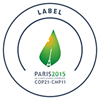�
Our Common Future Under Climate Change
International Scientific Conference 7-10 JULY 2015 Paris, France

NASA's Goddard Space Flight Center/Ludovic Brucker
Ice cores, corals and tree rings � What do they tell us about climate change?
201507-27
By By Laura Mukhwana (International Development Research Centre) and Helen McGregor (University of Wollongong)
Researchers have developed a new high-resolution, high-precision ice core record that shows that variations in organic carbon from land leads to decade-to-decade variation in carbon dioxide in the atmosphere.
This is a major advance as it puts strong limits on the source of land carbon to the atmosphere prior to the industrial period, according to scientists at the Our Common Future Under Climate Change Conference.
Ice cores, tree rings and coral bed rings are formed from the incremental buildup of new material. Each layer of ice, tree ring or coral growth band stores information on climate, (for example in the form of atmospheric gases or water availability) that allows paleoclimatologists to reconstruct climatic phenomena that have occurred over the past 1000 years.�
�We use past climates as natural experiments to project what will happen in the future,� said Valerie Masson-Delmotte, a paleoclimatologist from the Climate and Environmental Sciences Laboratory (LSCE) during a conference session on climate variability over the past millennia.
Data collected from these so-called �natural archives� are used to test climate models. Studying past climates on global and regional scales expands our understanding of variations and changes in the climate way before thermometers and modern instruments were invented. It also gives insights on future climate change projections by allowing us to look at what affected the past climates that may possibly affect the future climate.�
All of this is crucial in making policy makers understand past climates and what it means for the future of their jurisdiction for purposes of planning for mitigation and adaptation.
Climate predictions and models often happen at a global scale, but technological advancements mean scientists are now able to make regional predictions on temperature and rainfall that will impact the day-to-day lives of people like storms, droughts and floods.
For example, the reconstruction of summer hydroclimate in Fennoscandia, Europe provided really useful information on past droughts events, essential to understanding the drivers of drought variability in different timescales.�
Interestingly, there is agreement between temperature simulations and reconstructions for the northern hemisphere. The picture is less clear for the southern hemisphere, primarily because of a lack of records of past climate. However, efforts are underway by research groups globally (e.g. the PAGES2k programs) to fill these data gaps and understand the correlation between factors that cause climate to change, and the climate system response.
This is part of a blog series written by volunteer social reporters profiling climate scientists, economists, social scientists and civil society members who are presenting and discussing innovative climate science at Our Common Future. For more follow and #CFCC15 on Twitter



